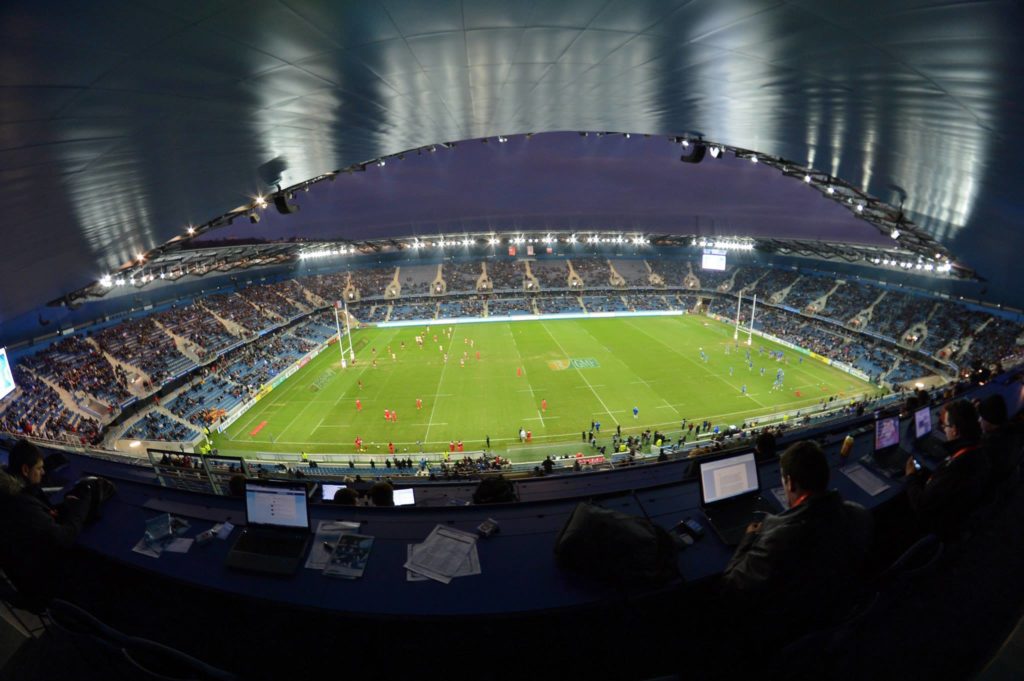
The 2019 Women’s World Cup, taking place June 7 through July 7, will be played in nine stadiums across France. This will be France’s first time hosting the event, though the country hosted the men’s World Cup in 1938 and 1998.
For the United States team, from a stadium perspective, the draw is a favorable one. All of their group stage matches, and potentially their early elimination rounds, will be conveniently close together.
The US team will open play against Thailand on June 11 at the Stade Auguste-Delaune in Reims, just outside Paris. The stadium was originally built in 1935, though it has been remodeled many times, most recently in 2008. With a capacity of 21,127, it is among the smallest venues at this year’s tournament. The stadium is visually striking for its floodlights that sit on nearly 250-foot masts that lean inwards toward the pitch. It can look like a cathedral, or a toothbrush holder, depending on your point of view.
The Americans’ second game, against Chile on June 16, will be played in Paris at Parc des Princes. Home of super club Paris St. Germain, the 47,929-seater is known for its great game atmosphere. The original Parc des Princes dates back to 1897 and served as the finish line of the Tour de France. The current stadium was built in 1972 and has undergone two refurbishments, most recently for Euro 2016. It is unique for being situated over a major highway, though you wouldn’t know it from inside.
The final group stage game of the tournament for the Americans will be played against rival Sweden at Stade Oceane in Le Havre, on the coast of the English Channel. Designers claim solar panels and other technologies make this Europe’s first “positive energy” stadium, producing more energy than it consumes. The exterior reflects the stadium’s name as it is adorned with ocean blue polymer shells. Also a smaller venue, with a capacity of just over 25,000, it is home to second tier French club Le Havre.
The U.S team is geographically lucky, as all three of its group stage games are in the same region in France, all relatively close to Paris. That should make travel, at least in the group stages, fairly simple. They may also be able to stay nearby for the early elimination rounds, as the winners of their group play in Reims, and runner-up play in Paris, in the Round of 16.
If the team is fortunate enough to make the semi-finals or finals, all three games will be held at the Parc Olympique Lyonnais, or Stade de Lyon, the largest and newest of this year’s venues. Designed by Populous, it opened in January of 2016 and has a capacity of almost 60,000. The stadium hosted the 2018 Europa League final and will be one of the sites for soccer in the 2024 Olympics. It is lauded for is modern feel and fan amenities, including over 6,000 VIP seats.
Other featured stadiums at this year’s tournament are spread throughout the country. The Allianz Riviera in Nice, and the Stade de la Mosson in Montpellier, are both on the Mediterranean coast. The Allianz Riviera, or Stade de Nice for the tournament, is a 35,000-seater opened in 2013. The Stade de la Mosson opened in 1972, though it was refurbished for the 1998 World Cup. It is known for flooding problems, and tenant Montpellier HSC is planning a new stadium with a plan to begin play in 2022.
Alpine Grenoble, site of the 1968 Winter Olympics, is home to another stadium – Stade des Alpes – in use this summer. Used for both soccer and rugby, the 20,000-seater was completed in 2008 after construction was delayed several years as protestors occupied ancient trees that were eventually chopped down to accommodate the new stadium. It will be the smallest, and perhaps the most scenic, stadium used in this World Cup.
The final two stadia at this year’s tournament, both in the north of France, are the Stade du Hainaut in Valenciennes and Roazhon Park, in Rennes. The Stade du Hainaut is unique as the pitch was dug in and laid significantly below sea level, resulting in a low structure, topping out at about 68 feet. Opened in 2011, it is covered in aluminum, giving it a modern look. Roazhon Park, originally built in 1912, and refurbished most recently in 2004, was re-named by a popular vote in 2015 – Roazhon means “Rennes” in Breton.
Although the US team is ranked at the top of the FIFA world rankings, it will face many challenges on its path to victory. Though its group isn’t particularly tough – Sweden is ranked 9th, Thailand is ranked 34th and Chile 39th – many tough squads await them in the elimination rounds. Many pundits have host France, ranked 4th by FIFA, as the favorites on their home turf. France will undoubtedly have a home field advantage – whether they can turn that into World Cup glory remains to be seen.
Whatever the result on the pitch, the 2019 Women’s World Cup will showcase soccer stadiums, big and small, across France. With their favorable geographic draw, and a little luck, hopefully the Americans will be hoisting the trophy in Lyon on July 7.
Image courtesy Stade Oceane.
